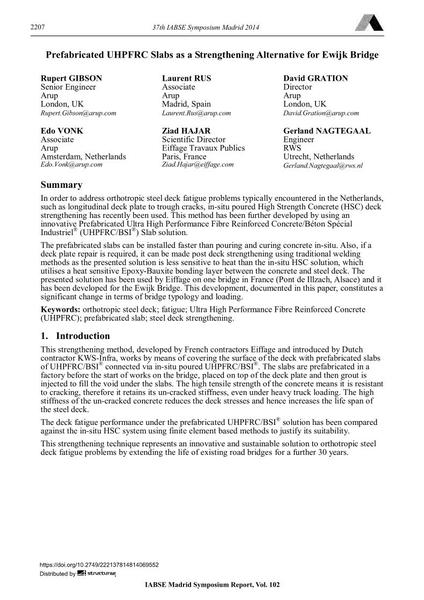Prefabricated UHPFRC Slabs as a Strengthening Alternative for Ewijk Bridge

|
|
|||||||||||
Détails bibliographiques
| Auteur(s): |
Rupert Gibson
Laurent Rus David Gration Edo Vonk Ziad Hajar Gerland Nagtegaal |
||||
|---|---|---|---|---|---|
| Médium: | papier de conférence | ||||
| Langue(s): | anglais | ||||
| Conférence: | IABSE Symposium: Engineering for Progress, Nature and People, Madrid, Spain, 3-5 September 2014 | ||||
| Publié dans: | IABSE Symposium Madrid 2014 | ||||
|
|||||
| Page(s): | 2207-2214 | ||||
| Nombre total de pages (du PDF): | 8 | ||||
| Année: | 2014 | ||||
| DOI: | 10.2749/222137814814069552 | ||||
| Abstrait: |
In order to address orthotropic steel deck fatigue problems typically encountered in the Netherlands, such as longitudinal deck plate to trough cracks, in-situ poured High Strength Concrete (HSC) deck strengthening has recently been used. This method has been further developed by using an innovative Prefabricated Ultra High Performance Fibre Reinforced Concrete/Béton Spécial Industriel® (UHPFRC/BSI®) Slab solution. The prefabricated slabs can be installed faster than pouring and curing concrete in-situ. Also, if a deck plate repair is required, it can be made post deck strengthening using traditional welding methods as the presented solution is less sensitive to heat than the in-situ HSC solution, which utilises a heat sensitive Epoxy-Bauxite bonding layer between the concrete and steel deck. The presented solution has been used by Eiffage on one bridge in France (Pont de Illzach, Alsace) and it has been developed for the Ewijk Bridge. This development, documented in this paper, constitutes a significant change in terms of bridge typology and loading. |
||||
